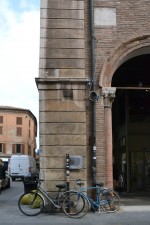Riots of 1831 and 1848

The riots of 1831 and 1841 saw a large Jewish participation in leading roles.
1. The riots of 1831
The ghetto gates, demolished by the French in April 1797 after their entry into Ferrara on 23 June of the previous year, closed again in 1815 with the Papal Restoration. On 12 February 1829, Pope Leo XII (1760-1829) died; he was of reactionary ideas and was disliked by the Jews, as well as a large number of Catholics; the Israelites hoped for a new, more benevolent pope but also the next one, Pius VIII (1761-1830) was a staunch conservative. However, his pontificate lasted only a few months and on 2 February 1831, Gregory XVI (1765-1846) was elected, more moderate and inclined to reforms. But in the meantime, riots led by the liberal bourgeoisie raged throughout Europe, following the example of the "three glorious days" of 27-28-29 July in France, which had overthrown Charles X (1757-1836), the last Bourbon. Only a few days after the election of Gregory XVI, on 7 February 1831, a provisional government was peacefully installed in Ferrara, without bloodshed as in Bologna and in some cities of Romagna. With the demolition of the gates of the ghetto on the 10th of February, the Jews were free citizens in all respects, following the example of the recent measures taken in France by the new King Louis Philippe d 'Orléans (1773-1850) in favour of the Jews in the decree voted in January and ratified on 8 February 1831, which repealed the restrictive provisions of 1816. On 6 March 1831, however, the Austrians reoccupied Ferrara and handed it back to the pope.
2. The riots of 1848
On 8 May 1833 "among the blame of citizenship" (Magrini 2015, p. 267), the relocation of the doors was ordered, but they were no longer closed. The riots of 1848 in Ferrara saw Abramo Pesaro, cousin of Isaac Pesaro Maurogonato, Minister of Finance of the Venetian Provisional Government and friend of the patriot and philanthropist Salvatore Hanau, in the foreground in the National Circle for the Revolution; also there was the painter Giuseppe Coen and Giuseppe Padova di Cento, who had obtained better treatment for the Jews of Ferrara from the pope and who would be among the most important hostages of the Austrians in 1849 for the papal restoration. Already on 13 August 1847, Cardinal Ciacchi had ordered the doors to be removed, without reference to the pillars that supported them; on 21 March 1848, the latter were knocked down by Christians and Jews together. On 14 October, the Ferrarese National Circle was established with Salvatore Hanau as secretary; on 19 February 1849, in the municipal elections, out of 57 councillors, four Jews were elected, including Giuseppe Coen. But on 15 May 1849, the Austrians, led by Generals Gorzkowski and Radetski, ordered the city to surrender, returning power to the pope, represented by the Pontifical Delegate Count Filippo Folicaldi, who had already made himself hated during the riots of 1831.
3. Retaliation
The pope could not forgive the leaders of the insurrection: Salvatore Hanau, who had already fled to Genoa, was expelled from the State of the Church and from Lombardy-Venetia; Giuseppe Coen moved to Venice; Dr. M. L. Finzi was dismissed from the Medical Academy of Ferrara.
The riots of 1848-1849, however, saw a much wider popular and Jewish participation in Ferrara than in those of 1831 and only another ten years would pass before emancipation and definitive civil equality.
4. Quotes
Testimony of Leone Ravenna
After the new erection of the gates in 1833, Leone Ravenna narrates: "However, ideas progressed and the ancient pariahs who now felt they were men, showed civil courage very rare in that era, offering passive resistance to higher orders. They did not move, the pillars had to be rebuilt from Office and the Community was then forced to reimburse the expense that was raised to 1,000 shields; invited to deliver the gates that in 1831 had been transported to the Israeli Cemetery, it refused and, while they were removed from there by force, the presidency of the University raised formal protest by means of a notary, then resorted to the Central Government and, especially interested in the Rothschild barons, obtained that, although the work already remained intact for the archiepiscopal will executed, the gates no longer closed". (Magrini 2015, p. 267)
On the demolition of the pillars of the Ghetto on 21 March 1848:
"This is how Leone Ravenna describes that event and recalled it with emotion in his late years:
'The news of the epic struggle in Milan and the riots in Venice had arrived on that day and the Ferrara people improvised an imposing demonstration [...] When the protesters arrived at the main road of the Ghetto, [...] some shouted: lower the pillars. It was like the spark that ignites the fire. A formidable unanimous lowering answered that invitation and everyone stopped loudly asking for hammers and pickaxes to demolish those leftovers of barbarism. [...] the large capitals that surmounted the pillars landed with long ropes and the cheering crowd followed the magnanimous example with impetus. […] universal joy was overflowing. Long live our Israelite brothers! cried the most distinguished Catholics. ‘Long live our Catholic brothers!' answered the Israelites unanimously. And they hugged each other in the middle of the street and kissed and tears of love and gratitude moistened all their eyelashes. / I was then a tender child; and yet that sublime, indescribable scene remained impressed on my heart and mind in such a way that, for years to come and for events to vary, I have not forgotten the most minute details, nor will I ever forget them, as certainly they were not forgotten or will be forgotten by everyone else who was lucky enough to attend’". (Magrini 2015, p. 277)
"On 28 March 1848 Massimo D’Azeglio (1798-1866) arrived in Ferrara with General Durando to coordinate the volunteers who were gathering. At the hotel ‘Dei Tre Mori’, where D’Azeglio was staying, a Jew appeared who I was not given to specify; he presented him with a sonnet dedicated to him, ‘Siam d 'Israel sons’, and he had his pamphlet on the emancipation of the Jews from D’Azeglio's own hands ". (Magrini 2015, p. 278)
"Among the Jews of Ferrara, certainly no less than among other citizens, it was a flourish of poets or pseudo-poets, all praising the new times. Not only Salvatore Anau, Dr. L.M. Finzi, the Rab. Isacco Ascoli, Moisè Contini, Abramo Pesaro, but we find Rab publications. Arnoldo Veneziani, ‘Roma’ and ‘Canto italico’, by Maestro Lampronti ‘Preghiera per l 'Italia’ (Sonnet), by Leon Vita Levi ‘La Festa’ (Hymn), by Vito Zamorani ‘Casa Bancaria d 'Austria’ (Speech)". (Magrini 2015, p. 280)
Bibliography
- Formiggini, Gina, Stella d’Italia Stella di David. Gli ebrei dal Risorgimento alla Resistenza, Mursia, Milano 1970
- Foà, Salvatore, Gli ebrei nel Risorgimento italiano, Carucci, Assisi-Roma 1978
- Magrini, Silvio, Storia degli ebrei di Ferrara. Dalle origini al 1943, Belforte, Livorno 2015 , pp. 263-282
Sitography
Related places
Related Subjects
Compiling entity
- Istituto di Storia Contemporanea di Ferrara
Author
- Edoardo Moretti
- Sharon Reichel

